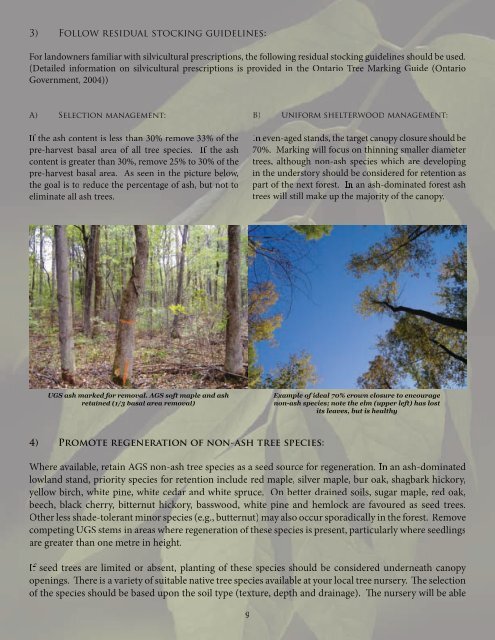Preparing for Emerald Ash Borer: A Landowner's Guide to Managing ...
Preparing for Emerald Ash Borer: A Landowner's Guide to Managing ...
Preparing for Emerald Ash Borer: A Landowner's Guide to Managing ...
- No tags were found...
Create successful ePaper yourself
Turn your PDF publications into a flip-book with our unique Google optimized e-Paper software.
3) Follow residual s<strong>to</strong>cking guidelines:For landowners familiar with silvicultural prescriptions, the following residual s<strong>to</strong>cking guidelines should be used.(Detailed in<strong>for</strong>mation on silvicultural prescriptions is provided in the Ontario Tree Marking <strong>Guide</strong> (OntarioGovernment, 2004))A) Selection management:If the ash content is less than 30% remove 33% ofthepre-harvest basal area of all tree species. If the ashcontent is greater than 30%, remove 25% <strong>to</strong> 30% ofthepre-harvest basal area. As seen in the picture below,the goal is <strong>to</strong> reduce the percentage of ash, but not <strong>to</strong>eliminate all ash trees.B) Uni<strong>for</strong>m shelterwood management:In even-aged stands, the target canopy closure should be70%. Marking will focus on thinning smaller diametertrees, although non-ash species which are developingin the unders<strong>to</strong>ry should be considered <strong>for</strong> retention aspart of the next <strong>for</strong>est. In an ash-dominated <strong>for</strong>est ashtrees will still make up the majority of the canopy.UGS ash marked <strong>for</strong> removal. AGS soft maple and ashretained (1/3 basal area removal)Example of ideal 70% crown closure <strong>to</strong> encouragenon-ash species; note the elm (upper left) has lostits leaves, but is healthy4) Promote regeneration of non-ash tree species:Where available, retain AGS non-ash tree species as a seed source <strong>for</strong> regeneration. In an ash-dominatedlowland stand, priority species <strong>for</strong> retention include red maple, silver maple, bur oak, shagbarkhickory,yellow birch, white pine, white cedar and white spruce. On better drained soils, sugar maple, red oak,beech, black cherry, bitternut hickory, basswood, white pine and hemlock are favoured as seed trees.Other less shade-<strong>to</strong>lerant minor species (e.g., butternut) may also occur sporadically in the <strong>for</strong>est. Removecompeting UGS stems in areas where regeneration of these species is present, particularly where seedlingsare greater than one metre in height.If seed trees are limited or absent, planting of these species should be considered underneath canopyopenings. There is a variety of suitable native tree species available at your local tree nursery. The selectionof the species should be based upon the soil type (texture, depth and drainage). The nursery will be able9
















